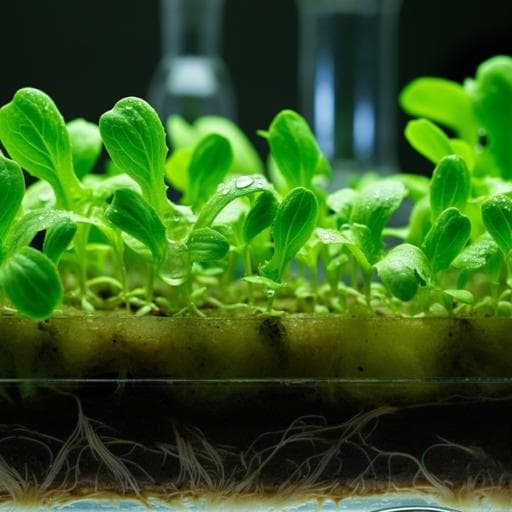
Agriculture
Plant growth promotion effect of plasma activated water on *Lactuca sativa* L. cultivated in two different volumes of substrate
V. Stoleru, R. Burlica, et al.
This pioneering study explores the transformative effects of plasma activated water (PAW) on lettuce growth, revealing significant enhancements in growth parameters and yield across various pot sizes. Conducted by a team of experts including Vasile Stoleru and Radu Burlica, the research provides valuable insights into innovative agricultural practices.
~3 min • Beginner • English
Introduction
The study addresses the need for sustainable, safe, and productive horticultural systems, particularly in soilless and hydroponic cultivation where controlled nutrition is essential. Non-thermal plasma (NTP) and plasma-activated water (PAW) have emerged as potential alternatives to chemical fertilizers and sanitizers, producing reactive oxygen and nitrogen species that can influence plant growth and safety. Lettuce (Lactuca sativa L.), a major leafy vegetable prone to nitrate accumulation, is commonly grown on artificial substrates with limited inherent nutrients. The research question is whether PAW at two reactive nitrogen concentrations (1.5 and 3.0 mg L⁻¹ NO₃⁻) can enhance germination, seedling growth, physiological traits (chlorophyll), morphology, yield components (foliar weight and area), and modulate nitrite/nitrate accumulation in lettuce, and how these effects interact with substrate volume (400 vs 3200 cm³). The purpose is to evaluate PAW as an alternative fertilization/biostimulation strategy and to identify optimal conditions that improve plant performance without compromising nitrate safety.
Literature Review
Prior work has shown that cold plasma technologies can improve microbial safety of produce, reduce pesticide residues, and modulate seed germination and early plant growth. Plasma-liquid interactions generate reactive species (e.g., H₂O₂, NOx, nitrite, nitrate) that alter water pH and conductivity and may serve as nutrient sources. Seed and water plasma treatments have increased germination rates and early growth in several species (maize, wheat, mung bean, rye), though responses depend on species, plasma type, water chemistry, and pH. In leafy vegetables, nitrate accumulation is influenced by cultivar, environmental conditions (light intensity), and agricultural practices; lettuce often accumulates high nitrate levels. Studies report that PAW irrigation can increase chlorophyll content and biomass in cereals and various horticultural species, with nitrate and nitrite from PAW acting as fertilizers, and H₂O₂ potentially signaling growth responses. However, high concentrations of reactive species can induce oxidative stress and potentially inhibit growth. The literature indicates limited consistent yield effects from NTP seed treatments alone but suggests potential benefits from PAW irrigation on biomass and pigment content, underscoring the need for controlled studies in lettuce with consideration of substrate volume and nitrate safety.
Methodology
Design: Experimental evaluation of PAW effects at two concentrations on lettuce (cv. Shangore F1) across two pot volumes, with dynamic measurements at 50, 57, and 64 days after transplanting (DAT). Replications: triplicate (3 reps), each with 15 plants (5 plants per harvest time).
PAW generation: Produced in a spray water plasma reactor with non-thermal plasma. Air flow maintained at 1.5 L min⁻¹; water flow rate adjusted to obtain two PAW treatments. Electrodes (E1 inlet nozzle, E2 outlet) were INOX tubular, 1 mm internal diameter, 4 mm gap, mounted coaxially in a glass reaction tube. The water–air mixture passed through the active plasma zone; PAW was collected at E2. Electrical parameters were held constant.
PAW treatments (Table 10):
- PAW I: pH 6.54; reactive nitrogen species reported as 1.5 mg L⁻¹ (NOx, specified in text as NO₃⁻); H₂O₂ 0.5 mg L⁻¹; water flow 3.00 L h⁻¹; applied 6 s per 5 mL.
- PAW II: pH 5.88; reactive nitrogen species 3.0 mg L⁻¹; H₂O₂ 1.65 mg L⁻¹; water flow 1.50 L h⁻¹; applied 12 s per 5 mL.
Seed germination assay: Shangore F1 seeds (purity 100%, 1050 seeds g⁻¹, 9% moisture) were soaked 5 h in distilled water, surface-sterilized with 70% ethanol 2 min, rinsed. Germinated in Petri dishes on filter paper at 20 °C, 80% RH, 1500 lx (lighted), in a growth chamber. Three groups (Control, PAW I, PAW II), each with 3 replicates of 100 seeds. First 48 h all groups received distilled water (5 mL) with covered dishes. After 48 h, a single-dose PAW spray (5 mL per dish) was applied at 10 cm from the outlet electrode: PAW I for 6 s, PAW II for 12 s; Control received 5 mL distilled water. Dishes were subsequently watered with distilled water to maintain moisture. Germination recorded daily from 3 to 7 DAS; seeds considered germinated when radicle ≥1 mm. Germination rate Rg = Ng/Nt × 100.
Seedling measurements: From each dish, 20 seedlings were randomly selected to measure radicle length (from 3 DAS) and hypocotyl length (from 5 DAS) over time.
Greenhouse cultivation: At 10 DAS, seedlings were pricked to a tray (288 cells) with Kekkila peat (90% OM, 65% moisture, pH 5.9, EC 44 mS m⁻¹; soluble N 1250 ppm, P₂O₅ 400 ppm, K₂O 2000 ppm). Light: day 3000 lx, night 1000 lx, 12/12 h. Fourteen days post-pricking, transplants were moved to pots with two substrate volumes: V1 = 400 cm³ and V2 = 3200 cm³, using the same substrate plus 5 g Orgevit organic fertilizer (N 4.0%, P₂O₅ 3.0%, K₂O 2.5%, MgO 1.0%, OM 65%, pH 7). Greenhouse conditions: day 13–14 °C, 70–75% RH, 25,000 lx; night 9–11 °C, 60–65% RH, 1000–2500 lx. Irrigation via Priva fertigation; pest/pathogen control per organic guidelines.
Measurements at 50, 57, 64 DAT:
- Chlorophyll content index (CCI) using CCM-200 plus Chlorophyll Content Meter (Opti-Sciences).
- Leaf area, leaf length, leaf width measured on all leaves of 5 plants per replicate using LI-3100C Area Meter.
- Root and leaf fresh weights via analytical balance (Kern).
- Leaf dry matter (% DW): oven-dried at 80 ± 2 °C to constant weight.
- Nitrite/nitrate contents: Dried samples extracted in hot water with saturated borax; clarified with potassium hexacyanoferrate(II) and zinc acetate; filtered to 25 mL. Nitrites determined by Griess method (Analytik Jena 200 Plus), expressed as mg NaNO₂ g⁻¹ DW. Nitrates measured after reduction to nitrite (cadmium), expressed as mg KNO₃ g⁻¹ DW (ISO 6635:1984 methodology referenced).
Statistics: Data as mean ± SD. One-way and two-way ANOVA with replication; Tukey post hoc test at P < 0.05 (SPSS v21.0).
Key Findings
- Germination: At 7 DAS, germination was 94% (Control) vs 95% (PAW I, PAW II); PAW did not significantly affect germination once initiated (<1–2% differences across days).
- Seedling growth: At 8 DAS, radicle length was higher with PAW I (53 mm) vs PAW II (50.9 mm) and Control (50.2 mm), a 5.58% increase vs Control. Hypocotyl length at 8 DAS: PAW I 8.9 mm vs Control 6.6 mm (+34.85%); PAW II showed smaller, later increases. Higher reactive species in PAW II (incl. H₂O₂ 1.65 mg L⁻¹; lower pH 5.88) may have tempered early seedling growth compared to PAW I.
- Chlorophyll content: Significant increase only for PAW II in large pots (V2). At 64 DAT, PAW II V2 showed +10.71% CCI vs Control V2; other treatment–volume combinations were similar to controls.
- Root fresh weight: No statistically significant differences among treatments at 50, 57, or 64 DAT in either pot volume. Numeric increases were observed with PAW, especially PAW II. Example 64 DAT V2: Control 11.76 ± 1.41 g; PAW I 12.03 ± 0.74 g; PAW II 12.20 ± 0.85 g.
- Foliar fresh weight (yield proxy): Strong pot volume effect. At 64 DAT: V1 Control 27.20 ± 0.78 g; PAW I 27.38 ± 0.30 g (+0.66%); PAW II 32.34 ± 1.42 g (+18.88%). V2 Control 75.11 ± 3.26 g; PAW I 83.23 ± 5.72 g (+10.8%); PAW II 93.88 ± 2.76 g (+24.99%). Similar trends at 50 and 57 DAT with PAW II > PAW I.
- Leaf area: Significantly larger with PAW II in V2. At 64 DAT: PAW II V2 2642.95 ± 76.59 cm² vs Control V2 2255.73 ± 89.53 cm² (+17.17%). Across treatments, V2 > V1 by 150–176% depending on group; smallest areas were in controls.
- Leaf length: Significant increase only for PAW II in V1 at 64 DAT (11.43 ± 0.29 cm) vs Control V1 (10.96 ± 0.33 cm; +4.29%). No significant effects otherwise.
- Leaf width: No significant treatment effects; at 64 DAT, V2 leaves wider than V1 by 32.15% (Control), 35.86% (PAW I), 38.71% (PAW II). PAW II generally > PAW I numerically.
- Dry matter (%): Higher in small pots (V1) than large (V2) at all harvests. PAW increased dry matter at specific times: significantly higher for PAW I and II in V2 at 57 DAT and in V1 at 64 DAT compared to corresponding controls.
- Nitrites: Very low across samples (0.004–0.02 mg NaNO₂ g⁻¹ DW). Generally lower in V2 than V1 regardless of treatment.
- Nitrates: Much higher in V2 than V1 (more than two orders of magnitude). V2 up to 36.406 ± 4.903 mg KNO₃ g⁻¹ DW (PAW I, 64 DAT); V1 remained <0.3 mg KNO₃ g⁻¹ DW. At 57 DAT, PAW treatments slowed the nitrate increase compared with Control V2; at 64 DAT, PAW-treated V2 plants had higher nitrate than controls, likely due to accumulation with plant aging.
- Correlations: Strong positive correlations between leaf weight and foliar area (~0.999), and between leaf length/width and foliar area (~0.99). Moderate correlations between foliar traits and pigments (0.51–0.58); higher between root weight and pigments (~0.726).
- Recommendation: For PAW-treated lettuce in large pots, harvest by 57 DAT (or as early as 50 DAT) to maintain nitrate levels at or below those in untreated lettuce.
Discussion
The findings indicate that PAW application does not alter lettuce seed germination once the process starts, aligning with literature that seed plasma treatments often have limited effects on final germination percentages. However, PAW at lower reactive nitrogen concentration (1.5 mg L⁻¹; PAW I) enhanced early seedling radicle and hypocotyl growth, likely due to beneficial signaling and nutrient effects of low-level reactive nitrogen and oxygen species. The higher PAW concentration (3.0 mg L⁻¹; PAW II), while less favorable for seedling elongation (potential mild oxidative stress and lower pH), produced clear improvements in chlorophyll content and biomass during later growth, particularly when the root system had more substrate volume (V2) to develop. This suggests a stronger long-term nutritional effect of higher nitrate availability in PAW II, improving photosynthetic capacity (higher chlorophyll) and translating to higher foliar mass and area.
Pot volume had a dominant effect on growth: larger substrate (V2) supported greater root and shoot development, amplifying the benefits of PAW (notably PAW II). Root weights increased numerically with PAW but not significantly, yet the enhanced root environment in V2 likely facilitated improved nutrient uptake, reflected in higher foliar weights and areas. The weak-to-moderate correlations between pigments and foliar traits, versus stronger correlations with root metrics, indicate that structural capacity and root development mediate the biomass response more than pigment levels alone.
Nitrate/nitrite dynamics showed that V2 plants accumulated substantially more nitrate in leaves, independent of treatment, consistent with greater uptake and storage capacity. PAW slowed nitrate accumulation at 57 DAT (suggesting diversion of nitrogen into antioxidant defenses under mild oxidative stress), but by 64 DAT, nitrate levels were higher in PAW treatments than controls, consistent with age-related accumulation. Therefore, PAW can enhance growth and quality (chlorophyll) while requiring attention to harvest timing to manage nitrate content. Overall, the results support the hypothesis that PAW, especially at higher reactive nitrogen levels and with adequate substrate volume, can promote lettuce growth and quality without compromising germination, provided management strategies are used to control nitrate at harvest.
Conclusion
PAW is a promising alternative biostimulant/fertilizer for lettuce grown on artificial substrates. In this study, PAW at 1.5 mg L⁻¹ NO₃⁻ improved early seedling growth without affecting germination, while PAW at 3.0 mg L⁻¹ NO₃⁻ increased chlorophyll content and enhanced foliar biomass and leaf area, particularly in larger pots (3200 cm³). Root weights were not significantly altered, but larger substrate volume magnified PAW benefits on shoot growth. Nitrites remained low across treatments; nitrates were much higher in large pots and were moderated by PAW at 57 DAT but increased at 64 DAT with PAW. To balance yield and nitrate safety, harvesting PAW-treated lettuce by 57 DAT (or earlier around 50 DAT in large pots) is advisable.
Main contributions: demonstration of PAW’s positive effects on lettuce chlorophyll and biomass under controlled substrate volumes; characterization of dynamic nitrate/nitrite responses; and practical harvest timing guidance.
Future research: optimize PAW dosing regimes and application frequency; evaluate different cultivars and growth systems (e.g., hydroponics); assess field-scale applicability; dissect mechanistic pathways linking reactive species to nutrient assimilation and antioxidant responses; and investigate long-term soil/substrate and microbiome effects.
Limitations
- Single lettuce cultivar (Shangore F1) under specific greenhouse conditions; generalizability to other cultivars/environments may be limited.
- Only two PAW concentrations and a single application timing for seeds; no comparison of repeated foliar/irrigation PAW applications during growth.
- Pot volume effects are strong; results may differ in open-field or recirculating hydroponics.
- Sample sizes per time point were modest (n=3 replicates; measurements on 5 plants per replicate), potentially limiting power for some traits (e.g., root weight, leaf dimensions).
- Nitrate data expressed as KNO₃ equivalents per DW; direct NO₃⁻ quantification and speciation in plant tissues and substrate were not provided.
- Potential variability in PAW composition over time and exact reactive species profiles beyond NOx and H₂O₂ were not deeply characterized.
Related Publications
Explore these studies to deepen your understanding of the subject.







